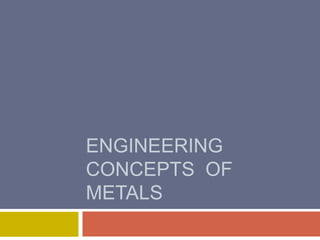
Metallurgy P R O P E R T I E S And Definitions
- 1. Engineering concepts OF METALS
- 2. HARDNESS Hardness is resistance to deformation. A number of methods are employed including Brinell, Vickers and Rockwell. In the case of steel, there is a common relationship between the Brinell hardness number (BHN) and the ultimate tensile strength (UTS) given in pounds force per square inch (psi): UTS(psi)=500BHN UTS (in MPa) = 3.45 BHN Brinell test is perhaps ideal for these property relationships because the values are given in units of mass per area of indentation; i.e., kg/mm2
- 3. BRINELL HARDNESS Hardness is not a fundamental property of a material, but a response to a particular test method. In general, an indenter is pressed into the surface of the material to be tested under a specific load for a definite time interval, and a measurement is made of the size or depth of the indentation.
- 6. ROCKWELL HARDNESS HRA . . . . Cemented carbides, thin steel and shallow case hardened steelHRB . . . . Copper alloys, soft steels, aluminium alloys, malleable irons, etc.HRC . . . . Steel, hard cast irons, case hardened steel and other materials harder than 1f00 HRB
- 8. SHEAR & TENSILE STRESS A shear stress, denoted (tau), is defined as stress which is applied parallel or tangential to a face of a material, as opposed to a normal stress which is applied perpendicularly.
- 9. SHEAR & TENSILE STRESS Consider a uniform bar of cross sectional area A subjected to an axial tensile force P. The stress at any section x-x normal to the line of action of the tensile force P is specifically called tensile stress pt
- 10. WORK HARDENING The increase in shear stress which causes an overall increase in strength of material is known as strain hardening or work hardening. It is used extensively to harden materials during working processes. The more the deformation the more the work hardening. The smaller the grain size, the more the work hardening.
- 11. GRAINS & GRAIN BOUNDARIES Metals commonly used for manufacturing consist of crystals in different orientation i.e. polycrystals. Each of the crystal grows into a crystalline orientation or grain. So each grain consists of either a single crystal or a polycrystalline aggregate. The surfaces that separate individual grains from each other are called grain boundaries. The crystal orientation changes abruptly across the grain boundary.
- 13. GRAINS & GRAIN BOUNDARIES The behavior of a single crystal or a single grain is anisotropic. The ideal behavior of a polycrystalline material is isotropic because the grains have a random orientation. Grain size influences the mechanical properties of a material. A large grain size is associated with low strength, low hardness & high ductility. Grain Boundaries effect the strength & ductility of the material.
- 14. HEAT TREATMENT Heat treatment is a method used to alter the physical, and sometimes chemical, properties of a material. Heat treatment involves the use of heating or chilling, normally to extreme temperatures, to achieve a desired result such as hardening or softening of a material. while the term heat treatment applies only to processes where the heating and cooling are done for the specific purpose of altering properties intentionally, heating and cooling often occur incidentally during other manufacturing processes such as hot forming or welding.
- 15. HEAT TREATMENT Softening: Softening is done to reduce strength or hardness, remove residual stresses, improve toughness, restore ductility, refine grain size or change the electromagnetic properties of the steel. Hardening: Hardening is done to increase the strength and wear properties. One of the pre-requisites for hardening is sufficient alloy content. Material Modification: Heat treatment is used to modify properties of materials in addition to hardening and softening. These processes modify the behavior of the steels in a beneficial manner to maximize service life.
- 16. Modulus of Rigidity: The ratio of shear stress to the displacement per unit sample length Relative stiffness of a material that allows it to resist bending, stretching, twisting or other deformation under a load. It is function of the material's modulus of elasticity (see Young's modulus) and shape.
- 17. Stiffness: The stiffness, k, of a body is a measure of the resistance offered by an elastic body to deformation (bending, stretching or compression).